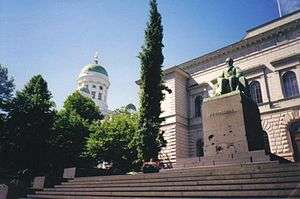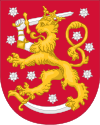Bank of Finland
The Bank of Finland (Finnish: Suomen Pankki, Swedish: Finlands Bank) is the central bank of Finland. It is the fourth oldest central bank in the world.[2]
| |||
| Headquarters | Helsinki | ||
|---|---|---|---|
| Established | 1 March 1812 | ||
| Ownership | 100% state ownership[1] | ||
| Governor | Olli Rehn | ||
| Central bank of | Finland | ||
| Reserves | 6 230 million USD[1] | ||
| Succeeded by | European Central Bank (1999)1 | ||
| Website | www.bof.fi | ||
| 1 The Bank of Finland still exists but many functions have been taken over by the ECB. | |||
History

The precursor of Bank of Finland, Waihetus-, Laina- ja Depositioni-Contori Suomen Suuren-ruhtinaanmaassa (The Exchange, Loan and Deposit Office of Finland), was established on 1 March 1812 in the city of Turku by Alexander I of Russia.[3][4] In 1819 it was relocated to Helsinki. Until 1840 the main purpose of the bank was to carry out currency reform to introduce Imperial ruble.[3] The Bank created and regulated the Finnish Markka from its inauguration in 1860 until Finland adopted the euro in 1999.[3]
Functions and ownership
The Bank of Finland is Finland's central bank and a member of the European System of Central Banks and of the Eurosystem.[5] It is Finland's monetary authority, and is responsible for the country's currency supply and foreign exchange reserves.
The Bank of Finland is owned by the Republic of Finland and governed by the Finnish Parliament, through the Parliamentary Supervisory Council and the Board of the bank. The Board is responsible for the administration of the bank, and the Parliamentary Supervisory Council for supervising the administration and activities of the bank and for other statutory tasks. The bank is governed under the provisions of the Act on the Bank of Finland, passed in 1998.
The bank has branch offices in Kuopio, Tampere, and Oulu. The bank has a staff of about 380 persons.[6]
Organisation
The highest official in the bank is the Governor (currently Olli Rehn) who also chairs the board. Members of the Board in August 2018 were Olli Rehn (Governor), Marja Nykänen (Deputy Governor) and Tuomas Välimäki.[6]
Governors of the Bank of Finland

- Claes Johan Sacklén 1812–1816
- Carl Johan Idman 1817–1820
- Otto Herman Lode 1820–1827
- Johan Gustaf Winter 1827–1841
- Carl Wilhelm Trapp 1841–1853
- Axel Ludvig Born 1853–1856
- Alex Federley 1853–1854
- Robert Trapp 1854–1856
- Frans Ivar Edelheim 1856–1858
- Wilhelm Blidberg 1858–1861
- Carl Isak Björkman 1862–1866
- Victor von Haartman 1866–1870
- August Florin 1870–1875
- Gustaf Samuel von Troil 1875–1884
- Alfred Charpentier 1884–1897
- Theodor Wegelius 1898–1906
- Clas Herman von Collan 1907–1918
- Otto Stenroth 1918–1923
- August Ramsay 1923–1924
- Risto Ryti 1923–1940
- Johan Wilhelm Rangell 1943–1944
- Risto Ryti 1944–1945
- Sakari Tuomioja 1945–1955
- Rainer von Fieandt 1955–1957
- Klaus Waris 1957–1967
- Mauno Koivisto 1968–1982
- Ahti Karjalainen 1982–1983
- Rolf Kullberg 1983–1992
- Sirkka Hämäläinen 1992–1998
- Matti Vanhala 1998–2004 (retired early due to illness)
- Erkki Liikanen 2004–2018
- Olli Rehn 2018–
Source: [7]
Chairmen of the Parliamentary Supervisory Council
- Antti Lindtman (2019–present)
- Matti Vanhanen (2015–2019)
- Ben Zyskowicz (2011–2015)
- Timo Kalli (2008–2011)
- Seppo Kääriäinen (2007–2008)
- Mari Kiviniemi (2006–2007)
- Olavi Ala-Nissilä (2003–2006)
- Mauri Pekkarinen (2003)
- Ilkka Kanerva (1995–2003)
- Sauli Niinistö (1995)
- Pentti Mäki-Hakola (1991–1995)
- Erkki Pystynen (1990–1991)
- Mauri Miettinen (1987–1990)
- Matti Jaatinen (1979–1987)
- Harri Holkeri (1971–1979)
- Juha Rihtniemi (−1971)
- Veikko Kokkola
- Juho Niukkanen
- Erik von Frenckell
See also
References
- https://d-nb.info/1138787981/34
- "History". Bank of Finland. Archived from the original on 28 October 2014. Retrieved 28 October 2014.
- Holtfrerich, Carl-L.; Reis, Jaime (5 December 2016). "The Emergence of Modern Central Banking from 1918 to the Present". Routledge – via Google Books.
- Wäxel- Låne och Depositions-Contoiret i Stor-Furstendömet Finland Archived 13 September 2017 at the Wayback Machine – Imperial ordinance by Alexander I of Russia, 20 November 1811 (in Russian)
- Bank of Finland. "Eurosystem and ESCB". Retrieved 12 September 2012.
- "Suomen Pankin organisaatio". Bank of Finland. Retrieved 14 April 2017.
- "Board Members in the history of the Bank of Finland". Bank of Finland. Archived from the original on 7 August 2017. Retrieved 13 April 2017.
External links
| Wikimedia Commons has media related to Bank of Finland. |
- (in Finnish, Swedish, and English) Bank of Finland official site
- Postage stamp commemorating the 150th anniversary of the Bank of Finland 1811–1961
- All the Finnish BIC-codes and an IBAN counter for all Finnish banks

